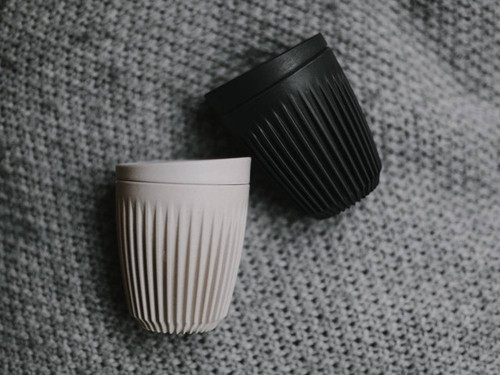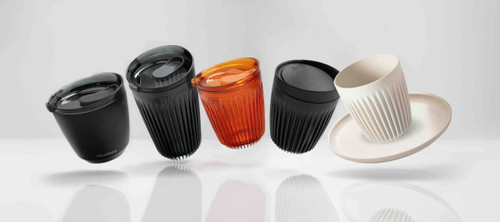Are Recyclable or Reusable Coffee Cups Better for the Environment?
Posted by Aless on 6th Aug 2025
Not all eco-friendly claims hold up, so what reduces waste? As sustainable coffee habits gain momentum, many consumers are torn between using a reusable coffee cup and relying on recyclable coffee cups. While both seem like green choices, the reality is often blurred by ambiguity and misinformation. Cutting through the confusion begins with understanding the true environmental impact of each option, so you can make a choice that supports the planet.
What Makes a Coffee Cup Reusable or Recyclable?

The difference between these two types of cups comes down to two things: design and material. Reusable coffee cups are purposefully engineered for repeated use and durability. Typically made from materials such as stainless steel, tempered glass, ceramic, BPA-free plastic, or even coffee-husk, these cups are designed to withstand daily wear and frequent washing. Their environmental benefit increases with continued use, as for every million reusable cups, used 15 times a year, 15 million disposable cups are avoided.
On the other hand, recyclable coffee cups are typically single-use paper cups with a thin plastic lining that makes them liquid-resistant. While they may be labelled as recyclable, this status depends heavily on the availability of specialised recycling infrastructure. As a result, less than 10% of these cups are actually recycled, with the majority ending up as waste that harms the environment and various marine life.
At Huskee, waste from the coffee production process, such as coffee husks, is repurposed into durable, beautifully designed, and barista-friendly coffee cups. The goal is to create a product you'll want to use for years, breaking the single-use cycle and turning waste into long-lasting value.
Energy and Resource Use in Reusable Coffee Cups
Manufacturing a reusable coffee cup, whether constructed from stainless steel, coffee husk, glass, or biopolymer, requires substantially more energy, water, and raw materials upfront compared to producing a single-use paper cup.
Over time, a well-used reusable cup reduces overall waste, energy consumption, and greenhouse gas emissions, making it more sustainable than relying on a constant stream of disposables. This is supported by Zero Waste Scotland which identified that after 10 to 41 uses, a reusable coffee cup has a lower equivalent carbon impact than using the same number of single-use cups and disposing them.
Manufacturing Impact of Recyclable Coffee Cups
Although the environmental impact of a single paper cup may seem minimal, the cumulative impact of recyclable coffee cups leads to significant waste and resource depletion. Globally, over 500 billion disposable cups are consumed annually, of which between 250-300 billion are plastic-lined paper cups, which mostly end up in landfills or litter.
Each disposable cup requires the harvesting of trees, significant water usage, and the production of plastic linings, all dedicated to a product typically used for around 15 minutes. The impracticability of recyclable coffee cups is further demonstrated in the discovery that the impact of manufacturing a new disposable cup is more than 90% greater than simply washing and reusing an existing cup. You’re throwing away a cup but also all the energy, water, and raw materials that went into making it, over and over again.
The Recycling Reality
Here’s where the "recyclable" dream falls apart. The journey of a disposable coffee cup after you put it in the recycling bin is rarely the clean, circular path we imagine. It’s a road full of dead ends.
Barriers to Recycling Recyclable Coffee Cups
The primary challenge lies in the waterproof plastic lining used in most disposable coffee cups. This lining, typically made from polyethene or similar plastics, is implemented to prevent leaks, but it also creates a composite material that standard recycling facilities are not designed to handle. Specialised equipment and processes are required to separate the plastic from the paper fibres, which adds complexity, time, and significant cost to recycling operations. This has led to the actual recycling rate for single-use recyclable cups being as low as 0-20%, despite dedicated efforts to collect them.
The Issue of Contamination in Recycling Processes
Even when recycling facilities are equipped to handle composite coffee cups, 19-40% of municipalities struggle with high contamination levels. Cups are often discarded with leftover liquids, which soak into the paper fibres and render them unrecyclable. Contaminated recyclables not only degrade the quality of the material but can also spoil entire batches as if a bale of recyclable paper is tainted with food or liquid waste, it may be deemed unusable and redirected to landfill.
Maintaining a clean recycling stream is essential for ensuring material recovery is both economically and environmentally viable. However, the high contamination rates associated with coffee cups, combined with the sheer volume in which they are disposed, make them one of the most problematic items in public recycling systems.
Understanding Downcycling vs. True Recycling
In the rare case that a single-use coffee cup does make it through a specialised recycling facility, it’s not turned back into another cup as most people think. Instead, these composite materials are downcycled. This is because the combination of paper and plastic is difficult to separate cleanly, so instead of being restored to their original form, the recovered fibres are repurposed into lower-grade products like park benches, construction panels, or insulation. While downcycling is preferable to landfill, it remains a linear process, as the material loses quality, can't be recycled again, and eventually ends up as waste. This approach instead delays disposal but doesn’t completely prevent it.
In comparison, true recycling operates within a closed-loop system, where materials are continually reused without degrading in quality.
For example, Huskee’s innovative HuskeeLoop program takes a truly circular approach by collecting damaged or end-of-life HuskeeCups and remanufacturing them into new and functional products. By preserving the quality of the original materials, this system keeps valuable resources in circulation for longer, significantly reducing waste and the need for virgin inputs.
Recycling Options for Reusable Cups
While reusable cups are built for long-term use, end-of-life recycling options depend heavily on the materials involved. Components like stainless steel, tempered glass, ceramic, and BPA-free plastic often require specialised recycling processes. They are not always accepted through standard curbside systems, especially when combined with silicone seals or plastic lids. As a result, many reusable cups still end up in landfill due to limited infrastructure or unclear disposal guidelines.
To combat this, options like HuskeeSwap provide a scalable cup exchange program designed to eliminate single-use waste in cafés by making reuse effortless for both consumers and businesses. Instead of relying on customers to bring their own clean cup every time, the system allows them to swap their used HuskeeCup for a fresh one at participating locations. This increases the frequency of reuse but also maintains hygiene and convenience standards, making it easier to embed sustainable habits into daily routines.
Evaluating Compostable Cups
What about compostable cups? While they may appear to offer a natural, eco-friendly alternative, compostable cups often fall into the same greenwashing pitfalls as recyclable ones, offering a promise of sustainability that rarely holds up under scrutiny.
These cups require the specific conditions found only in industrial composting facilities like high heat, controlled humidity, and specialised microbial activity, to break down effectively.
Unfortunately, most households lack access to such infrastructure, and when compostable cups are mistakenly thrown into general waste or backyard compost bins, they either fail to degrade or decompose anaerobically in landfills, releasing methane, a greenhouse gas far more potent than carbon dioxide. As a result, these products often end up exacerbating the environmental issues they were designed to solve.
Making Choices for Our Environment
So, which has a bigger impact: reusable or recyclable cups? Well, when used consistently, reusable cups are better option for the environment. Single-use cups, regardless of their label, contribute to a global waste crisis driven by convenience rather than sustainability.
The most impactful choice you can make is to break that cycle. Buying a reusable cup is the first step. Every time you choose reuse, you support a future that prioritises durability, quality, and circularity over disposability and waste. Shop at the Huskee store today, and commit to the reusable system.


